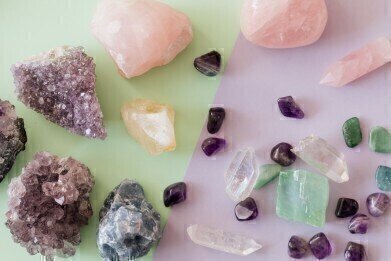News & Views
Why are Gemstones Different Colours?
Nov 05 2014
Emeralds, diamonds, topaz, opal - what is their most defining feature? For most of us, the answer will be the same - their colour. From vibrant reds to earthy greens, gemstones are characterised by their appearance. They adorn jewellery and are even used in healing practices. But what determines the colour of gemstones?
We perceive different hues because objects absorb certain lightwaves and reflects others. A purple flower is not inherently purple. Instead, it reflects certain wavelengths and absorbs others. Our brain sees only the reflected colour. If an object appears white, it is reflecting all colours - and conversely black objects are absorbing all wavelengths. So with this in mind, what makes gemstones different colours?
The science behind gemstones and their colours
Every gemstone has its own unique chemical and atomic structure. Diamonds are made of carbon, rubies and sapphires of aluminium chloride - and so on. This, along with the presence of impurities, leads to the absorption of different wavelengths of light. The result is that gemstones vary in colour.
Just as colours vary from gemstone to gemstone, so too do gemstones of the same type. Some, including Topaz and Spinel, come in a variety of colours, depending on the impurities present. Green is usually caused by chromium ions replacing aluminium, while iron within corundum produces blue.
Some gemstones, such as Alexandrite, vary in colour depending on external conditions. In natural light, Alexandrite appears green - simply because there is more green present in natural light. By contrast, it appears red in incandescent light. It’s all about perception.
Colours and chemistry
The colour of a gemstone can, in part, be predicted by where elements appear in the periodic table - because this indicates its ‘behaviour’. If an element in the first line of the period table is present within a gemstone, it will appear colourless. But the transition metals found in the middle section of the periodic table can reflect coloured light - because of the ‘d orbitals’ where electrons reside. That means they will appear as differing colours - from deep oranges to dazzling blues.
But it’s not all about transition metals. When a gemstone absorbs certain wavelengths of light, it can cause a transfer of electrons between ions, which affects colour. This happens with sapphires.
One thing’s for sure - the science of gemstone colours is far from simple. The chemical makeup of each gemstone can vastly affect its colour: so for example the presence of chromium in emeralds will produce its characteristic green, while the same impurity in corundum will produce red.
When chemistry is not responsible, human intervention may be the reason for a gemstone’s colour. Gem treatments can deepen or lighten colour, or increase clarity. Methods include heat treatments, surface coating or bleaching.
Lightwave Internet
Lightwaves do more than determine the colour of an object! A new generation of high-speed internet technology which is more secure and versatile than Wi-Fi, will be developed at a new research centre recently opened at the University of Edinburgh. This light-based communication technology, also known as Li-Fi - which is transmitted using light waves instead of existing radio technology - is seen as the successor to the latest 4G wireless internet systems which came on stream in the UK in 2012. You can read about this development in this article: Making Light of Web Overload.
Digital Edition
Lab Asia 31.2 April 2024
April 2024
In This Edition Chromatography Articles - Approaches to troubleshooting an SPE method for the analysis of oligonucleotides (pt i) - High-precision liquid flow processes demand full fluidic c...
View all digital editions
Events
May 05 2024 Seville, Spain
InformEx Zone at CPhl North America
May 07 2024 Pennsylvania, PA, USA
May 14 2024 Oklahoma City, OK, USA
May 15 2024 Birmingham, UK
May 21 2024 Lagos, Nigeria





.jpg)












